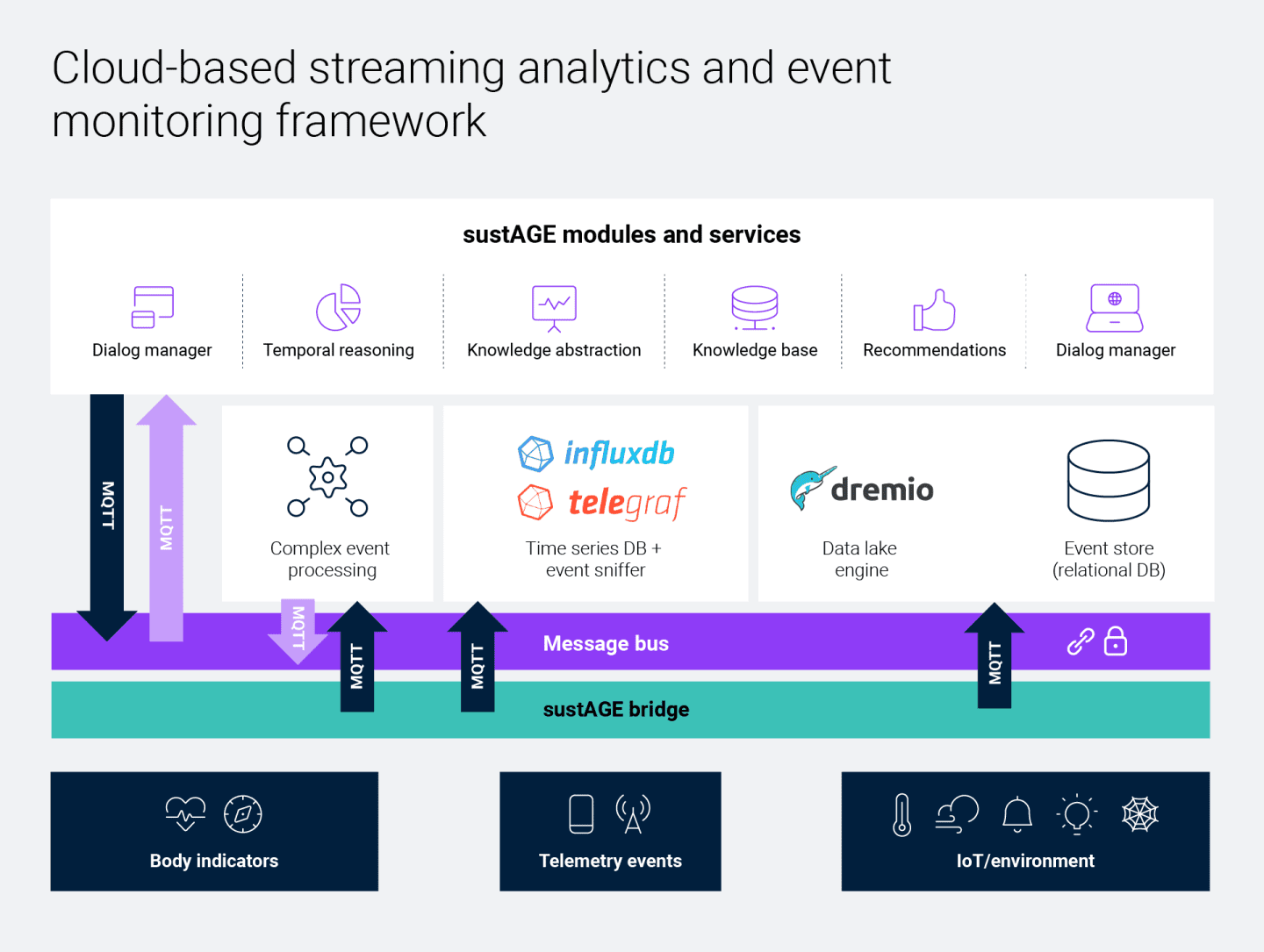It’s hot, take a break: sustAGE app connects IoT with an aging workforce
Software AG’s messaging bus is the digital backbone for a person-centric, intelligent solution designed to monitor the safety of workers up to retirement.

Increasing life expectancy and the significant shortage of skilled workers require modern industry to revise working conditions. They must be designed to be age-appropriate and allow the inclusion of aging workers up to retirement age. Companies will increasingly have to meet these challenges. In the European research project sustAGE, ten partners, including Software AG, have developed and prototyped a person-centric, intelligent solution.
Smartwatches, smartphones, cameras, environmental sensors, and location-based systems enable this change through the continuous monitoring of workers’ conditions. They all collect certain vitality and location parameters to answer questions such as: Is the heartrate too high? Is the worker’s activity in accordance with sound posture conditions for his work on a specific machine?
With the information from the devices, the developed assistance system can help the particular person to perform certain activities, improve their cognitive abilities such as alarming when tired, and provide advice for their health and well-being such as: “It’s hot outside and you seem stressed. Take a break.”
Users interact with the system via a smartphone and smartwatch. The devices run customized apps. The sustAGE app has been developed with the course of the project. It is intuitive, easy to use, and has already been tested by volunteers at two pilot sites. These are application scenarios in the automotive industry and in port logistics, where work is physically demanding. Of course, ethical considerations and aspects of data protection were included in the discussions of the research work.
When the smartwatch warns of danger
Data from smartwatches, smartphones, and smart sensors such as temperature, humidity, dust, and light intensity on factory floors flows through Software AG’s messaging bus — the solution’s data backbone — and is distributed from there throughout the platform. For example, the Recommendation Engine accesses the data from the messaging bus and then responds directly.
But not only sensors provided the data; a stereo camera was also used for 3-D imaging. From this, stick figures can be derived that visualize the behavior and posture of the worker during work. In this way, situations can be identified and monitored where, for example, the worker has performed the last 36 shoulder movements incorrectly and subjected that shoulder to unhealthy tension or flexion. To avoid serious, long-lasting complications with certain body parts, posture deviations are recorded, analyzed, and the user is informed accordingly via the app.
An alarm from the app can even prevent threatening, dangerous situations in the workplace when loading and unloading containers, as the following example shows: A worker is standing on a container ship when a container on the crane comes dangerously close to him. Using a 3-D camera, the position of the moving container is analyzed in three-dimensional space and translated into an absolute GPS coordinate via the relative position of the crane. This position is constantly compared with the absolute position of the worker’s smartwatch. A vibration on the worker’s smartwatch indicates whether the worker is in the immediate vicinity of the moving container, thus avoiding critical and dangerous situations.
What is the technology behind this?
Events form the backbone of communication. A message broker, Software AG’s messaging bus, ensures that all communication is reliable and secure. More than 60 types of events have been defined. The events, along with all the worker parameters, are sent via the MQTT network protocol to the messaging bus, which distributes all the data to the platform participants involved (see figure).
In Software AG’s Apama Streaming Analytics tool, the individual event streams are analyzed, correlated, aggregated, and new events are generated. For example, heart rate variation, i.e., the deviation between two successive regular heartbeats, were calculated and average values defined for all participants. Or the “Feels like” temperature index was determined, which is based on the combination of temperature, wind speed, and humidity and provides a better heat estimate than just using temperature values.
The events are then distributed to other applications via the messaging bus. For example, the Recommendation Engine becomes active. It sends a recommendation to the worker’s app to take a break via the messaging bus.

A dashboard for different user groups has been implemented in sustAGE: Aging employees, for example, receive an overview of the number of posture deviation they have or their average heart rate, while team leaders of the current shift receive an overview of vitality of their employees with partially anonymized data such as BMI. The company doctor, on the other hand, has a different information interest, as they primarily review the workforce data that is relevant to them.
Innovative and ready for the market
The innovation management was very successful in this project, which was in the hands of an Innovation Management Board (IMB) and led by our research colleague Dr. Frank Werner. The list of innovations is long — five innovations even made it onto the European Commission’s Innovation Radar. The Innovation Radar is an initiative to identify innovations and innovators with high potential in EU-funded research and innovation projects. One of these innovations was developed by Software AG. Anomaly detection and parameter prediction involves the analysis and use of machine learning models that capture and predict micro-moments based on events such as heart rate, location (indoors, outdoors), and environmental conditions (temperature, humidity, pressure, air quality, wind, noise, dust, luminance). Micro-moments specify a set of independent actions that describe a worker’s activity, working conditions, or health status.

How can these five innovations and components be bundled to provide a solution for an existing market? What is the unique selling point of each of these components? How long does it take to establish the solutions in the market? Where are the risks, where are the stumbling blocks? All these questions have already been studied and answered within the project, to leverage the go-to-market of these innovations post project. One application is even already being used at the University of Thessaloniki. It implements a service for campus-wide navigation and orientation with coordinates and alters. A start-up has further developed an innovation from sustAGE. This is how research bears fruit.